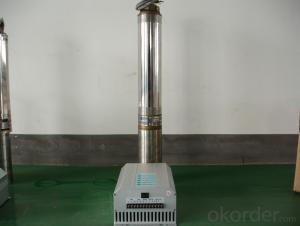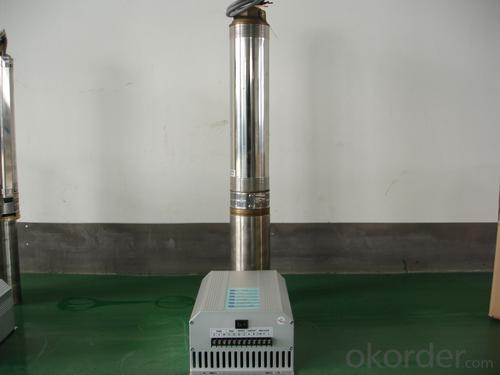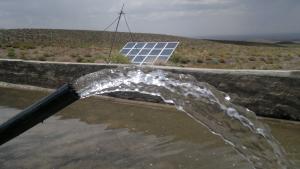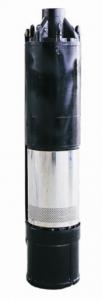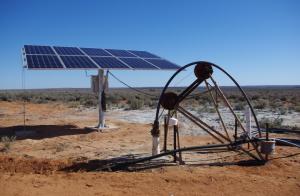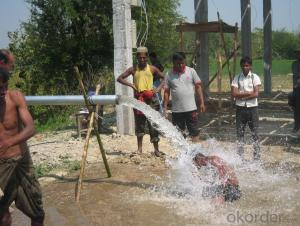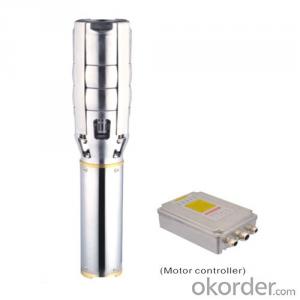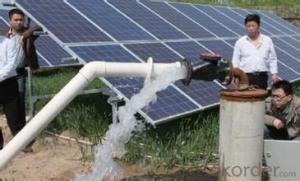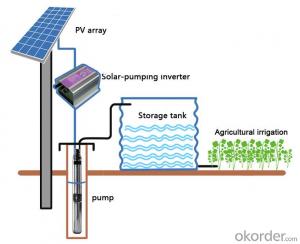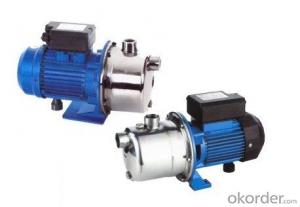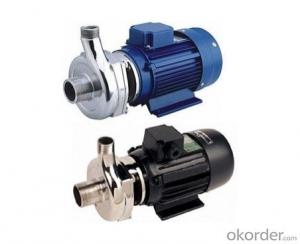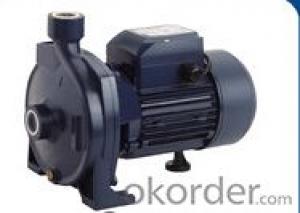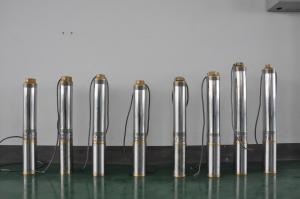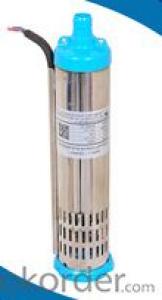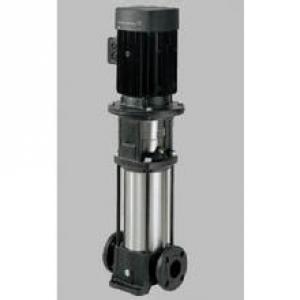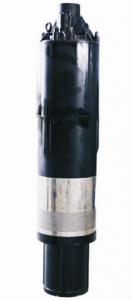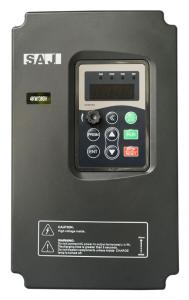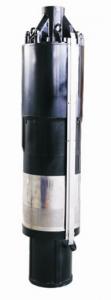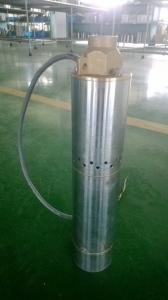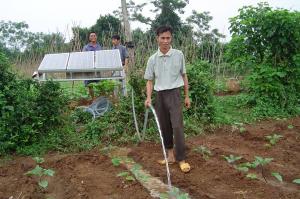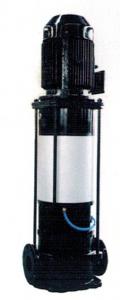Small Solar Water Pump
- Loading Port:
- China Main Port
- Payment Terms:
- TT OR LC
- Min Order Qty:
- -
- Supply Capability:
- -
OKorder Service Pledge
OKorder Financial Service
You Might Also Like
Item Description :
This superb new addition to our solar fountain range comes with a 10w solar panel,and a powerful fountain pump that is capable of producing fountains of up to 2m in height. As well as being easy to set up and use.Instruction manual is supplied for assembly and maintenance.
Solar Fountain Key Features :
Powered by direct sunlight
No high voltage electric mains required
Safe for children
Max. height of fountain: 2M
Max. flow capacity: 800 L/H(176 GAL)
10W Polycrystalline solar panel included
18V DC brushless pump
Solar Pump Features :
Can produce fountains up to : 2M (tube height) 1.4M (fountain height)
Comes with multiple nozzle accessories
Cable Length : 5M
Solar Panel Features :
10W peak power.
Polycrystalline highly efficient solar panel
Comes mounted in aluminium frame
Comes with ground stake and rotating knob so you can angle your panel toward the sun
What You Will Get :
10W solar panel
Solar pump
Ground Sake
Nozzle accessories
Precautions :
DO NOT alter or change the product itself or its components
Operate pump in freshwater only, never above 50 degrees celsius
Keep away from flammable liquids
Do not connect to any other power supply other than the included
- Q: How does the cost of maintaining a solar pump compare to a traditional pump?
- The cost of maintaining a solar pump generally tends to be lower compared to a traditional pump. This is primarily due to the fact that solar pumps do not rely on electricity from the grid, which eliminates the need for expensive electrical connections and ongoing electricity bills. Solar pumps are powered by renewable energy from the sun, making them more cost-effective in the long run. In terms of maintenance, solar pumps have fewer moving parts compared to traditional pumps, which reduces the likelihood of mechanical failure and the need for frequent repairs. Additionally, solar pumps do not require fuel or oil changes, further reducing maintenance costs. Moreover, solar pumps have a longer lifespan compared to traditional pumps, typically lasting for 20-25 years or more. Traditional pumps, on the other hand, may need to be replaced or repaired more frequently, increasing the overall cost of maintenance. It is important to note that the initial installation cost of a solar pump may be higher than that of a traditional pump. However, considering the lower maintenance and operational costs over its lifespan, a solar pump often proves to be a more cost-effective and sustainable option in the long term.
- Q: Are solar pumps suitable for use in botanical research centers?
- Yes, solar pumps are suitable for use in botanical research centers. They are environmentally friendly, cost-effective, and can provide a reliable source of water for irrigation, hydroponic systems, and other research purposes. Additionally, solar pumps can be easily integrated into existing infrastructure and require minimal maintenance, making them a practical choice for botanical research centers.
- Q: Can a solar pump be used in areas with high levels of iron in the water?
- Yes, a solar pump can be used in areas with high levels of iron in the water. However, it is important to note that the iron content may pose certain challenges and require additional precautions. Iron in the water can cause clogging and damage to the pump system, affecting its efficiency and lifespan. Therefore, it is advisable to install proper pre-filtration systems or iron removal mechanisms to prevent any potential issues and ensure the longevity of the solar pump.
- Q: Can solar pumps be used for water supply in remote hospitality or tourism facilities?
- Yes, solar pumps can be used for water supply in remote hospitality or tourism facilities. Solar pumps are an eco-friendly and sustainable solution for water supply in such locations as they utilize solar energy to pump water, eliminating the need for grid electricity or fossil fuels. They can provide a reliable and cost-effective water supply for remote facilities, ensuring a consistent and uninterrupted water source for guests and staff. Additionally, solar pumps require minimal maintenance and have a long lifespan, making them a practical choice for remote hospitality and tourism facilities.
- Q: Are there any restrictions on using a solar pump in agriculture?
- Yes, there can be certain restrictions on using a solar pump in agriculture. Some potential limitations include the availability of sunlight, which can affect the efficiency of the pump, especially in regions with frequent cloudy or rainy weather. Additionally, the initial cost of installing a solar pump can be higher compared to traditional pumps, which may pose financial constraints for some farmers. It is also important to consider the size and capacity of the solar pump, as it may not be suitable for large-scale irrigation needs.
- Q: Can solar pumps be used for water supply in remote manufacturing or industrial sites?
- Yes, solar pumps can indeed be used for water supply in remote manufacturing or industrial sites. Solar pumps are highly versatile and efficient, making them an ideal choice for remote locations where access to electricity may be limited. They can provide a reliable and sustainable water supply for various industrial processes, such as manufacturing, cooling, or irrigation, without the need for grid power. Additionally, solar pumps offer cost savings by reducing reliance on fuel-powered generators or costly infrastructure installations.
- Q: Can a solar pump be used for irrigation of crops or gardens?
- Yes, a solar pump can be used for irrigation of crops or gardens. Solar pumps are designed to harness the power of the sun to pump water from a source, such as a well or a pond, to the desired location. These pumps are particularly useful in areas where access to electricity is limited or non-existent. Solar pumps for irrigation provide a sustainable and cost-effective solution for farmers and gardeners. They can be used to irrigate fields, orchards, vineyards, and gardens of all sizes. The solar panels convert sunlight into electricity, which powers the pump to draw water from the source and distribute it to the desired area. One of the major advantages of using solar pumps for irrigation is their low operating cost. Sunlight is free and abundant, so once the system is installed, there are no fuel or electricity costs associated with running the pump. This makes solar pumps an economically viable option, especially for small-scale farmers and gardeners. Additionally, solar pumps are environmentally friendly as they do not produce any greenhouse gas emissions during operation. They also reduce dependence on fossil fuels, contributing to a cleaner and more sustainable energy future. Solar pumps come in various sizes and capacities, allowing for customization based on the specific irrigation needs of crops or gardens. They are designed to be durable, reliable, and require minimal maintenance. In conclusion, solar pumps can indeed be used for the irrigation of crops or gardens. They provide a sustainable and cost-effective solution, while also reducing environmental impact. With advancements in technology, solar pumps have become increasingly efficient and reliable, making them an excellent choice for irrigation purposes.
- Q: How does the slope of the terrain affect the installation of a solar pump?
- The slope of the terrain can significantly impact the installation of a solar pump. A flat or gently sloping terrain is generally easier to work with as it requires less structural adjustments and leveling. On the other hand, a steep slope might require additional measures such as building a foundation or constructing a platform to ensure proper stability and alignment of the solar pump system. Moreover, the slope can also affect the positioning of solar panels to maximize their exposure to sunlight. Overall, the slope of the terrain must be carefully considered during the installation process to ensure the efficient and effective operation of the solar pump.
- Q: What is the maximum temperature a solar pump can withstand?
- The maximum temperature a solar pump can withstand varies depending on the specific model and manufacturer. However, typically, solar pumps can withstand temperatures ranging from -40°C to 60°C or even higher in some cases. It is always advisable to refer to the manufacturer's specifications for the exact maximum temperature limit of a particular solar pump model.
- Q: How does a solar pump help in reducing the risk of power outages?
- A solar pump reduces the risk of power outages by relying on solar energy as its power source instead of relying on the electrical grid. This means that even during power outages or disruptions to the grid, the solar pump can continue to operate independently, ensuring a constant water supply without interruptions.
Send your message to us
Small Solar Water Pump
- Loading Port:
- China Main Port
- Payment Terms:
- TT OR LC
- Min Order Qty:
- -
- Supply Capability:
- -
OKorder Service Pledge
OKorder Financial Service
Similar products
Hot products
Hot Searches
Related keywords
